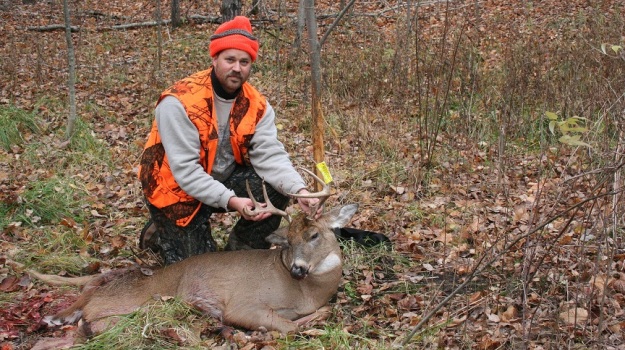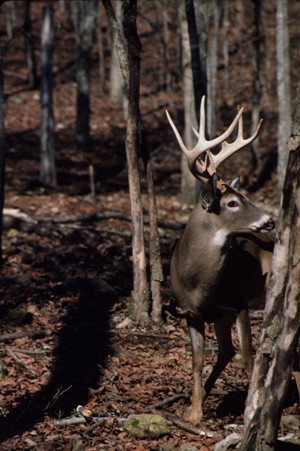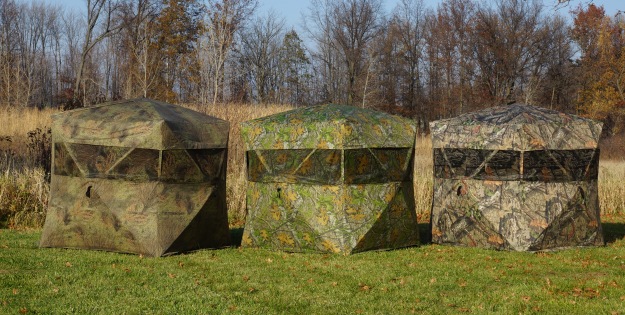Go Where Others Won’t Like Swamps to Take Public Land Buck Deer

Editor’s Note: Fifty-year-old Kevin Hutchings, from Howell, Michigan, which is located close to Ann Arbor, has been hunting deer as long as he can remember. He was one of the original Mossy Oak Pro Staffers.
Because I spend a lot of time up in trees, I like Mossy Oak Treestand pattern the best. Mostly, I hunt public lands. Michigan is one of the states with a tremendous number of deer hunters. For too many years, I think we've been studying how to find and hunt deer, instead of concentrating on what causes deer to be at certain places at specific times. For me, the real key to hunting deer on public lands is to try and find places that are extremely difficult for other sportsmen to reach to hunt. Most hunters want an easy in, easy out stroll to their deer stands, but I've learned that I either have to find a swamp that no one wants to go into, or I have to crawl and scratch to get to places where no one else wants to hunt. Most of the time I hunt public land with rolling terrain, hills, dips and swamps, at least a mile from any access road. Much of the public land I hunt has horse trails or bicycle trails that I can use to walk in about a mile or more to start hunting. When I leave the horse trail or the bike trail, I look for either thick cover or swampy type terrain. Most of the time, I’ll travel about 200 yards or more off those trails to find some rough places to hunt. Primarily, I like to hunt in swamps where dry land creates a pinch point that deer can enter the swamps, cross the swamps and get to dry land on the other side. Another factor that hunters often overlook is that deer will bed in the swamps - possibly on a dry spot on a little patch of weeds that may only be 3-4 feet in circumference. By bedding down in a place like this, they can hear, see and smell any hunters coming to them. I have friends who wear waders, or if the water gets up too high, they’ll use a canoe. But I don’t get out in water that’s any deeper than knee-high rubber boots myself.
On much of the public land where I hunt, there are cornfields on the edges of the public lands. I’ve found that the highest number of hunters often will be on the trails leading into and out of those cornfields. In the swamps, I’ll often locate land out of the water where there are acorn trees. When the hunting pressure builds-up on the cornfields, I’ve found the deer will feed on acorns during daylight hours and on the corn at night. One of the advantages I have by hunting in the swamp is that in the afternoon, the deer bedding on the high spots in the swamp will start moving toward the cornfields before dark. I’ll hear them splashing in the water. When they get out of their beds and start moving toward the swamp in the mornings, I can hear the deer splashing in the water when they’re returning from the cornfields.
If I set-up on a pinch point where all the deer are funneling into the swamp from where they're bedding, I can see deer activity that other hunters won’t spot. An ideal place for me to hunt is a narrow strip of land with water on both sides, and some oak trees dropping acorns, maybe 50 to 100 yards out in the swamp. The good news about finding a place like this is that the deer will be using that kind of pinch point to go back and forth to their bedding area and to their primary food source - the cornfields. If there’s an obvious feeding site like a cornfield, most public-land hunters will hunt around the corn. However, often, they forget that the deer also like acorns, and their movement patterns are directly affected by the amount of hunting pressure they encounter.
 Now, the deer don’t stop feeding on corn. Most of the time the corn is on private land just off the public land, so they’ll have to feed on that corn at night once the hunters have left the woods. Hunters hunting active trails in and out of the corn and fresh trails that go out toward the corn may not realize that those deer are going to the cornfield at night or before daylight. So, I'm actually hunting their secondary food source – the acorns – that’s on high ground out in the flooded timber. I'm not really hunting over the acorns. I'm hunting the trail that comes from the cornfield and goes out into the swamp.
Now, the deer don’t stop feeding on corn. Most of the time the corn is on private land just off the public land, so they’ll have to feed on that corn at night once the hunters have left the woods. Hunters hunting active trails in and out of the corn and fresh trails that go out toward the corn may not realize that those deer are going to the cornfield at night or before daylight. So, I'm actually hunting their secondary food source – the acorns – that’s on high ground out in the flooded timber. I'm not really hunting over the acorns. I'm hunting the trail that comes from the cornfield and goes out into the swamp.
I hunt most state and federal lands that can be as small as 100 acres or perhaps several thousand acres. I concentrate on areas that are 1,000 acres or more, because these places are where you usually have the highest hunting pressure. I put my tree stand at a 90-degree angle to the trails that the deer are using to enter or exit the swamp. I like to be able to shoot accurately all the way across the pinch point, because the deer don’t always come down a trail in the middle of the pinch point. Sometimes, they’ll come down one side or the other side of the water, so I want to be able to shoot across the pinch point.
Another reason I like to get well away from access roads is because most hunters fear the thought of taking a buck in one of these gnarly places away from a road. They realize they’ll have to drag him through briars and brambles and possibly a mile or more to get back to the truck. These hunters almost seem afraid of being successful. Although most public land hunters want an easy hunt, I've learned that deer hunting is like any other form of work. The more effort you put into it; the better results you'll get from that work. Another advantage I have is that I hunt public land that I've hunted for years. So, I've learned the deer’s movement patterns, but more importantly, I've learned the hunters’ movement patterns.
To learn more about hunting, check out John E. Phillips’ new eBook and print book, “Bowhunting Deer: Mossy Oak Pros Know Bucks and Bows.” You also can download a free Kindle app that enables you to read the book on your iPad, computer or Smartphone.
For information on making jerky from your deer to provide a protein-rich snack, you can download a free book from http://johninthewild.com/free-books.
Tomorrow: The Early Bird Gets the Worm and the Buck with Kevin Hutchings




























